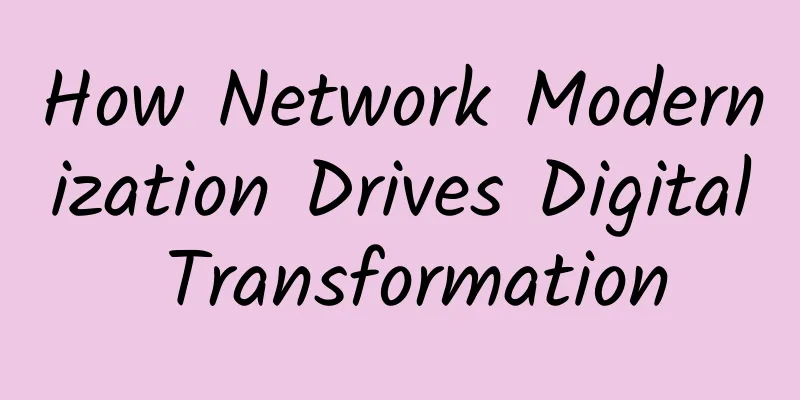How Network Modernization Drives Digital Transformation

|
The fact is that the global outbreak of the COVID-19 pandemic has had an unprecedented impact on people’s daily work and life - involving people’s work, education, healthcare, social interactions, and many necessities in the fragile global supply chain. Therefore, IT organizations in all industries around the world are forced to accelerate their digital transformation strategies. Equinix recently released a global technology trend survey report. In the survey, 2,600 IT technology leaders described the impact of the epidemic on their global digital infrastructure plans. According to the survey results, 60% of IT technology leaders said that they modified their IT strategies due to the epidemic; 47% of IT technology leaders said that they accelerated their digital transformation plans. In addition, 58% of IT leaders regard network interconnection as a key driver of digital transformation, which is an increase of 9% over last year's survey results. The biggest advantage of network interconnection they mentioned is increased flexibility, followed by improvements in network optimization. More than half of IT technology leaders said that network interconnection will help them gain a competitive advantage, and 50% of IT technology leaders believe that network interconnection is key to the survival of their business. Building application-centric networks for future-proof digital infrastructureA recent ITPro white paper titled “Enhancing IT Resilience to Disruption” recommends three key IT strategies to ensure business resilience and continued growth:
The basic principles behind these strategies may seem subtle, but they have important implications in delivering optimal performance, scalability, and security when shifting workloads between distributed users, clouds and IT infrastructure, and across an ecosystem of partners and service providers. The secret ingredient behind all of these principles is “proximity.” By placing IT infrastructure and network access service provider resources (e.g., cloud platforms, networks, SaaS, etc.) at the edge, close to the users, systems, and services that need them most, enterprises will achieve the network optimization and flexibility required for modern digital infrastructure. In a recent report, IDC noted, “For enterprises to successfully digitally transform and become competitive businesses of the future, they need enhanced connectivity, often in the form of a digitally native network. This is an application-centric network that provides the right end-user experience for every application and user.” Equinix and AT&T have joined forces to help their customers transform their networks so they get the performance and security they need, whether their applications are in the public cloud or on-premises. How Equinix and AT&T are modernizing their networksEquinix and AT&T are improving businesses through greater network optimization and agility. For more than six years, the two companies have been selling solutions to businesses of all sizes around the world. In fact, Equinix recently named AT&T its Global Transformation Reseller and Americas Partner of the Year. As a global digital infrastructure provider, Equinix has more than 220 data centers around the world and the largest and most active global ecosystem of network, cloud computing and IT service providers, enabling digital leaders to bring together and connect the infrastructure that drives their success. AT&T has established direct network connections in most of Equinix's global data centers and has a faster 5G network. This collaboration provides enterprises with industry-leading network connectivity solutions that accelerate digital transformation plans while reducing network latency, increasing flexibility and improving overall network performance. Equinix and AT&T's network connectivity solutions enable enterprises to facilitate seamless and secure data exchange between edge and core infrastructure, as well as between partners and providers. By leveraging Equinix Fabric™ and its extensive portfolio of cloud-connected data centers, AT&T customers can transform their networks and accelerate the deployment of hybrid multi-cloud architectures. Whether applications are in the public cloud or in vendor-neutral Equinix facilities, they can achieve the global performance, security and manageability required by today's enterprises without having to backhaul all workloads over traditional MPLS networks. Combined with AT&T's solutions, Equinix provides hybrid multi-cloud with "last mile" access. The Equinix platform provides direct access to pre-built AT&T Ethernet networks through Equinix Fabric, including AT&T Switched Ethernet (ASE), AT&T On-Demand Switched Ethernet, and AT&T Dedicated Ethernet (ADE), with connection speeds up to 100G. This includes all AT&T WAN services, including EPLS-WAN, AT&T Virtual Private Network, and AT&T Dedicated Internet. Enterprises that need global software-defined interconnection can choose AT&T NetBond® for Cloud, which supports direct connections to many industry-leading cloud service providers. Virtual Connect through Equinix Fabric simplifies fast access to the AT&T network from most Equinix IBX® data centers, with direct connections to AT&T WAN services and pre-built AT&T Ethernet networks. According to the 2021 State of the Cloud Survey released by Flexera, more than 92% of enterprises today have adopted a multi-cloud strategy. With Equinix Fabric, AT&T and Equinix customers can quickly (in minutes rather than months) deploy multiple virtual connections to any number of cloud computing service providers (CSPs), connecting to each cloud computing service provider (CSP) through a single physical port with multiple circuits, thereby significantly saving cloud connection costs. With so many direct and secure "cloud entrances" within Equinix's global data centers, the use of virtual private networks on the Internet is reduced because enterprises have dedicated connections to the cloud computing service providers (CSPs) of their choice. Equinix Fabric also interconnects its customers’ global digital infrastructure on the Equinix platform, enabling greater regional cloud access and redundancy. By deploying Equinix Fabric software-defined interconnection in strategic metropolitan hubs, its customers can have reliable access between Equinix’s multiple cloud availability zones around the world. How you design your network is importantHow an enterprise designs its network does matter. The architecture should take into account the applications that are most important to it and how and where they are used. Ultimately, it should enable enterprises to manage and exchange data globally while reducing latency, risk and cost, and increasing scale and performance. Equinix and AT&T help digital leaders build and interconnect hybrid IT infrastructures that can be easily replicated in strategic locations that are important to their business. This will enable enterprises to transform the way they interconnect with their users, applications and partner ecosystems, and ultimately enable their business to grow rapidly. |
<<: Flink 1.14 New Features Preview
>>: Ruijie's all-scenario cloud desktop leads the new trend of Internet medical development
Recommend
Jiaxing Cloud Road: Tongxiang Smart Education and the 6 Major Projects Behind It
When the thousand-year-old ancient town Wuzhen wa...
What is optical networking? Full explanation
Optical networking is a technology that uses ligh...
CUBECLOUD VPS Hosting 12% off, Hong Kong CN2 GIA/Los Angeles CN2 GIA/AS4837 optional
CUBECLOUD has launched a promotional activity cal...
The acceleration of 5G NR standardization will have a significant impact on operator plans
Ovum said that the recent decision by 3GPP to acc...
Key Roles of Artificial Intelligence in Mobile App Development
[[431728]] 【51CTO.com Quick Translation】 Today, t...
Seven key points! Understand the "Threat Information Blue Report" released by Weibu Online and China Academy of Information and Communications Technology
On December 3, 2021, the Security Research Instit...
Private 5G: Accelerating towards the Fourth Industrial Revolution (4IR)
Analysts report that private 5G adoption is incre...
New infrastructure defines the new connotation of data center
At this year's National People's Congress...
Cloud computing and the Internet of Things complement each other, but what are the differences between them?
Cloud computing and the Internet of Things are tw...
Ministry of Industry and Information Technology: my country breaks through 5G key technologies and commercial equipment will be launched before the end of the year
According to CCTV reports, at the 2018 5G Summit ...
Huawei CloudEngine 16800 becomes the "new engine" of Beijing Institute of Technology's National New Energy Vehicle Monitoring and Management Platform
On August 9, 2019, Huawei held the "Unleashi...
edgeNAT September Promotion: 20% off for monthly VPS and 30% off for annual VPS starting from 48 yuan/month, in the US/Hong Kong/Korea data centers
edgeNAT has launched a promotional event for the ...
NVIDIA Ethernet Acceleration xAI Builds World's Largest AI Supercomputer
Oct. 28, 2024—NVIDIA announced that xAI’s Colossu...
How to Unlock a Network
Application-centric networking enables their ente...
Four trends to watch out for in 2018
Even with all the coffee or energy drinks in the ...


![[Black Friday] RAKsmart cloud servers are 30% off, cluster servers are half price for the first month, flash sales servers start at $30/month](/upload/images/67cac22501dd5.webp)






